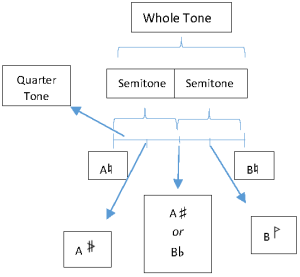—————————————————————-
A “scale” is a sequence of ascending or descending musical notes that have a certain frequency ration. The notes in an ascending form are named: Do (C), Re (D), Mi (E), Fa (F), Sol (G) La (A), Si (B), and Do (C). This sequence is repeated from lower frequencies (base) to higher frequencies (treble).
In western music, the minimum frequency ratio is defined as a semitone, and a whole tone consists of two semitones (i.e. a whole tone); the ratio of the frequency of a higher note to that of a lower note is 9/8. Thus, a whole tone can be equally divided to two semitones. The major scale in western music has the following tonal pattern:
Whole – whole – semi – whole – whole – whole – semi
This pattern can be used to make a scale from any note. For example, C major starts from C following the tonal pattern shown above. Thus the following pattern with natural notes (♮) is yielded:
C♮ -D♮ -E♮ -F♮ -G♮ -A♮ -B♮
In consequence, for making the major scale from another note, some of the notes have to be tuned a semitone higher or lower than natural note (♮). They are referred to “accidentals” in music. The accidentals are named as follows:
- Natural (♮)
- Sharp (♯)
- Semitone higher than natural
- Flat (♭)
- Semitone lower than natural
In Persian music, a whole tone is divided to four quarter tones. Therefore there are two more accidentals in Persian music as follows:
- Sori
- Quarter tone higher than natural
- Koron
- Quarter tone lower than natural

“Dastgah” and “Maye” in Persian Music
Traditional Persian music is known as “Moosighi-ye Sonnati”. It consists of 7 scales or 12 modes. Although a scale can be referred to “Gam” in Persian music, I believe that it has the closest meaning to “Dastgah”. On the other hand, mode is known as “Maye”, “Tantalite”, or “Avaz”.
The seven scales (Dastgah) and their five modes (Maye) are as follows:
- Shoor
- Abuata
- Bayet-e Tork
- Afshari
- Dashti
- Segah
- Chargah
- Homayoun
- Mahoor
- Nava
- Rast-Panjgah
The following is an example of an improvisation in Shoor performed by Jalil Shahnaz (tar) and Houseyn Ghavami (vocalist):
In the next posts, I will explain each Dastgah in more details.
